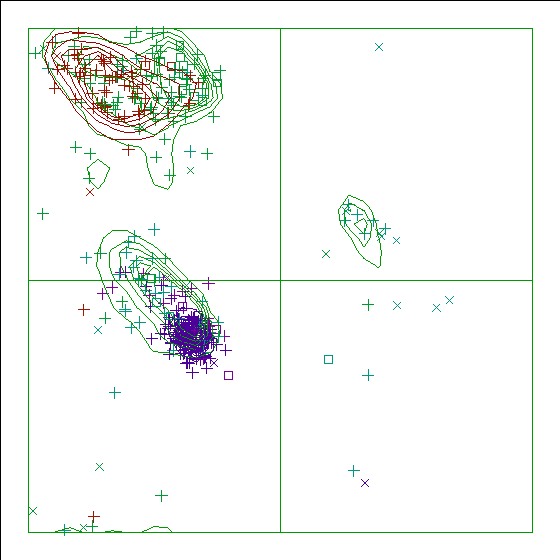
Improper dihedrals are a measure of the chirality/planarity of the structure at a specific atom. Values around -35 or +35 are expected for chiral atoms, and values around 0 for planar atoms. Planar side chains are left out of the calculations, these are better handled by the planarity checks.
Three numbers are given for each atom in the table. The first is the Z-score for the improper dihedral. The second number is the measured improper dihedral. The third number is the expected value for this atom type. A final column contains an extra warning if the chirality for an atom is opposite to the expected value.
370 ASN ( 376 ) C 6.6 12.5 0.0 371 PRO ( 377 ) N 7.0 26.9 -1.5
Improper dihedral RMS Z-score : 0.584
Note: Chain names are OK
All chain names assigned to polymer molecules are unique, and all
residue numbers are strictly increasing within each chain.
Note: Weights checked OK
All atomic occupancy factors ('weights') fall in the 0.0--1.0 range.
Geometric checks
Note: No missing atoms detected
All expected atoms are present.
Warning: C-terminal oxygen atoms missing
The C-atoms listed in the table below belong to a C-terminal residue
in a protein chain, but the C-terminal oxygen ("O2" or "OXT") that it
should be bound to was not found.
422 TYR ( 428 ) C
Atom names starting with "<" belong to the previous residue in the chain. If the second atom name is "--SS", the disulphide bridge has a deviating length.
371 PRO ( 377 ) CD N 1.317 -11.1
RMS Z-score for bond lengths: 0.789
RMS-deviation in bond distances: 0.017
Note: No bond length directionality
Comparison of bond distances with Engh and Huber [REF] standard
values for protein residues and Parkinson et al [REF] values for
DNA/RNA does not show significant systematic deviations.
Warning: Unusual bond angles
The bond angles listed in the table below were found to deviate
more than 4 sigma from standard bond angles (both standard values
and sigma for protein residues have been taken from Engh and Huber
[REF], for DNA/RNA from Parkinson et al [REF]). In the table below
for each strange angle the bond angle and the number of standard
deviations it differs from the standard values is given. Please
note that disulphide bridges are neglected. Atoms starting with "<"
belong to the previous residue in the sequence.
226 PHE ( 232 ) CA CB CG 117.936 4.1 371 PRO ( 377 ) CG CD N 95.665 -5.0
RMS Z-score for bond angles: 0.898
RMS-deviation in bond angles: 1.788
Note: Side chain planarity OK
All of the side chains of residues that have a planar group are
planar within expected RMS deviations.
Note: Atoms connected to aromatic rings OK
All of the atoms that are connected to planar aromatic rings in side
chains of amino-acid residues are in the plane within expected RMS
deviations.
Warning: Unusual PRO puckering amplitudes
The proline residues listed in the table below have a puckering
amplitude that is outside of normal ranges. Puckering parameters
were calculated by the method of Cremer and Pople [REF]. Normal PRO
rings have a puckering amplitude Q between 0.20 and 0.45
Angstrom. If Q is lower than 0.20 Angstrom for a PRO residue, this
could indicate disorder between the two different normal ring forms
(with C-gamma below and above the ring, respectively). If Q is
higher than 0.45 Angstrom something could have gone wrong during the
refinement.
4 PRO ( 4 ) 0.17 LOW 107 PRO ( 107 ) 0.14 LOW 196 PRO ( 196 ) 0.13 LOW 230 PRO ( 236 ) 0.16 LOW 248 PRO ( 254 ) 0.18 LOW 259 PRO ( 265 ) 0.15 LOW 371 PRO ( 377 ) 0.50 HIGH
68 PRO ( 68 ) -62.7 half-chair C-beta/C-alpha (-54 degrees) 342 PRO ( 348 ) 104.4 envelop C-beta (108 degrees) 371 PRO ( 377 ) -165.0 half-chair N/C-delta (-162 degrees) 376 PRO ( 382 ) -45.8 half-chair C-beta/C-alpha (-54 degrees)
These scores give an impression of how ``normal'' the torsion angles in protein residues are. All torsion angles except omega are used for calculating a `normality' score. Average values and standard deviations were obtained from the residues in the WHAT IF database. These are used to calculate Z-scores. A residue with a Z-score of below -2.0 is poor, and a score of less than -3.0 is worrying. For such residues more than one torsion angle is in a highly unlikely position.
371 PRO ( 377 ) -3.0057 342 PRO ( 348 ) -2.8409 68 PRO ( 68 ) -2.6023 231 THR ( 237 ) -2.4351 387 LEU ( 393 ) -2.3732 199 VAL ( 199 ) -2.2959 183 LEU ( 183 ) -2.2164 373 THR ( 379 ) -2.1597 386 GLY ( 392 ) -2.1033 124 ARG ( 124 ) -2.0980 379 LEU ( 385 ) -2.0576 272 VAL ( 278 ) -2.0551 48 GLN ( 48 ) -2.0523 418 GLY ( 424 ) -2.0197 211 PRO ( 211 ) -2.0045
Residues with ``forbidden'' phi-psi combinations are listed, as well as residues with unusual omega angles (deviating by more than 3 sigma from the normal value). Please note that it is normal if about 5 percent of the residues is listed here as having unusual phi-psi combinations.
68 PRO ( 68 ) Poor PRO-phi 158 SER ( 158 ) Poor phi/psi 161 ARG ( 161 ) Poor phi/psi 210 LEU ( 210 ) PRO omega poor 211 PRO ( 211 ) Poor PRO-phi 223 ASP ( 229 ) Poor phi/psi 242 ASP ( 248 ) Poor phi/psi 250 LEU ( 256 ) PRO omega poor 251 PRO ( 257 ) Poor PRO-phi 269 GLY ( 275 ) Poor phi/psi 270 LYS ( 276 ) Poor phi/psi 273 ARG ( 279 ) Poor phi/psi 274 GLY ( 280 ) Poor phi/psi 314 ALA ( 320 ) Poor phi/psi 342 PRO ( 348 ) Poor PRO-phi 343 SER ( 349 ) Poor phi/psi 350 ILE ( 356 ) Poor phi/psi 357 GLU ( 363 ) Poor phi/psi 365 GLN ( 371 ) Poor phi/psi 371 PRO ( 377 ) Poor phi/psi 374 GLY ( 380 ) Poor phi/psi 376 PRO ( 382 ) Poor PRO-phi 386 GLY ( 392 ) omega poor 419 GLY ( 425 ) Poor phi/psi
Ramachandran Z-score : -1.741
Warning: Omega angles too tightly restrained
The omega angles for trans-peptide bonds in a structure are
expected to give a gaussian distribution with the average around
+178 degrees and a standard deviation around 5.5 degrees. These
expected values were obtained from very accurately determined
structures. Many protein structures are too tightly constrained.
This seems to be the case with the current structure, as the
observed standard deviation is below 4.0 degrees.
Standard deviation of omega values : 3.513
Note: chi-1/chi-2 angle correlation Z-score OK
The score expressing how well the chi-1/chi-2 angles of all residues
are corresponding to the populated areas in the database is
within expected ranges for well-refined structures.
chi-1/chi-2 correlation Z-score : -1.476
Note: Ramachandran plot
In this Ramachandran plot X-signs represent glycines, squares represent
prolines and small plus-signs represent the other residues. If too many
plus-signs fall outside the contoured areas then the molecule is poorly
refined (or worse).
In a colour picture, the residues that are part of a helix are shown in blue, strand residues in red. "Allowed" regions for helical residues are drawn in blue, for strand residues in red, and for all other residues in green.

Chain without chain identifier
Accessibility related checks
Note: Inside/Outside residue distribution normal
The distribution of residue types over the inside and the outside of the
protein is normal.
inside/outside RMS Z-score : 1.025
Note: Inside/Outside RMS Z-score plot
The Inside/Outside distribution normality RMS Z-score over a 15
residue window is plotted as function of the residue number. High
areas in the plot (above 1.5) indicate unusual inside/outside
patterns.
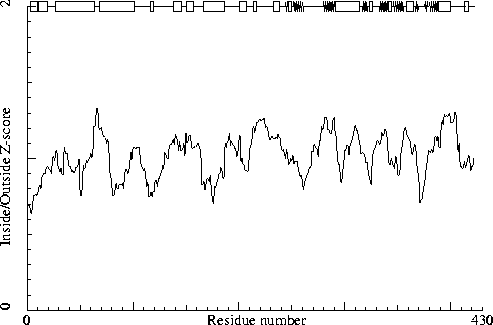
Chain without chain identifier
Secondary structure
Note: Secondary structure
This is the secondary structure according to DSSP. Only helix (H), strand
(S), turn (T) and coil (blank) are shown. [REF]
DBG> SSBOND cards to be written: 0
DBG> SSBOND cards to be written: 0
10 20 30 40 50 60
| | | | | |
1 - 60 MLDPKILRQNLEHVVEKLRRRGFEMDSDTFLQLENKRKEAQLAIQSFQTKRNQLSKTIGM
1 - 60 HHHHHH HHHHHHHHHTTT HHHHHHHHHHHHHHHHHHHHHHHHHHHHHHHHHH
70 80 90 100 110 120
| | | | | |
61 - 120 AKSKGENPELLMAEVSQLNDELKQEEANFETIQKAFSDFQLAIPNLPHDSVPDGKSENDN
61 - 120 HHHTT HHHHHHHHHHHHHHHHHHHHHHHHHHHHHHHHHT TTT TT333
130 140 150 160 170 180
| | | | | |
121 - 180 REIRQWGAPPGFDFTPKDHTVLGERDNQLDFEAAAKLSGARFVVLRGSLARAHRALAQFM
121 - 180 T TT HHHHHHHTT HHHHHHHT TT HHHHHHHHHHHHHH
190 200 210 220
| | | |
181 - 220 LDLHTDQHGYEEVYVPYLVHEECLYGTGQLPKFREEQFQV
181 - 220 HHHHHHTT TT HHHHHHHT TTTT333T
230 240 250 260 270 280
| | | | | |
221 - 280 AGDRNFFLVPTGEVPLVNLARDEIIEAPALPKKWVAQTPCFRSEAGSYGKDVRGMIRQHQ
221 - 280 TTTHHHHHHTTTT SSS333 SSSSSSSSSS T TT T TS
290 300 310 320 330 340
| | | | | |
281 - 340 FQKVELVQLVQPENSYQALEEITRQAEKVLQLLALPYRVVELCAGDLGFAAAKTYDLEVW
281 - 340 SSSSSSSSSS 333HHHHHHHHHHHHHHHHHHHT SSSSS 333T TT TSSSSSSSS
350 360 370 380 390 400
| | | | | |
341 - 400 LPSQNKYREISSCSNCEDFQARRIQARWRNPKTGKPELLHTLNGSGLAVGRTLVAVMENY
341 - 400 S333TSSSSSSSSSS TTHHHHHHT SSS TTT SSS SSSSSSSSSHHHHHHHHHHHT
410 420
| |
401 - 422 QQADGHIRVPDALKSYMGGVDY
401 - 422 TTT TTT333TTT
The contact distances of all atom pairs have been checked. Two atoms are said to `bump' if they are closer than the sum of their Van der Waals radii minus 0.40 Angstrom. For hydrogen bonded pairs a tolerance of 0.55 Angstrom is used. The first number in the table tells you how much shorter that specific contact is than the acceptable limit. The second distance is the distance between the centers of the two atoms.
The last text-item on each line represents the status of the atom pair. The text `INTRA' means that the bump is between atoms that are explicitly listed in the PDB file. `INTER' means it is an inter-symmetry bump. If the final column contains the text 'HB', the bump criterium was relaxed because there could be a hydrogen bond. Similarly relaxed criteria are used for 1--3 and 1--4 interactions (listed as 'B2' and 'B3', respectively). If the last column is 'BF', the sum of the B-factors of the atoms is higher than 80, which makes the appearance of the bump somewhat less severe because the atoms probably aren't there anyway.
Bumps between atoms for which the sum of their occupancies is lower than one are not reported. In any case, each bump is listed in only one direction.
163 VAL ( 163 ) CG2 -- 278 GLN ( 284 ) NE2 1.099 2.001 INTRA 163 VAL ( 163 ) CG2 -- 278 GLN ( 284 ) CD 0.747 2.453 INTRA 369 ARG ( 375 ) C -- 371 PRO ( 377 ) CD 0.640 2.560 INTRA 369 ARG ( 375 ) O -- 371 PRO ( 377 ) CD 0.554 2.246 INTRA 148 GLN ( 148 ) CG -- 166 ARG ( 166 ) O 0.478 2.322 INTRA 148 GLN ( 148 ) CB -- 169 LEU ( 169 ) CB 0.461 2.739 INTRA 163 VAL ( 163 ) CG2 -- 278 GLN ( 284 ) OE1 0.437 2.363 INTRA 299 LEU ( 305 ) O -- 303 THR ( 309 ) CG2 0.338 2.462 INTRA 369 ARG ( 375 ) CG -- 371 PRO ( 377 ) CD 0.295 2.905 INTRA 229 VAL ( 235 ) CG1 -- 231 THR ( 237 ) O 0.291 2.509 INTRA 10 ASN ( 10 ) O -- 11 LEU ( 11 ) C 0.269 2.531 INTRA BF 419 GLY ( 425 ) O -- 420 VAL ( 426 ) C 0.253 2.547 INTRA 149 LEU ( 149 ) CD2 -- 151 PHE ( 151 ) CE2 0.249 2.951 INTRA 381 THR ( 387 ) C -- 382 LEU ( 388 ) CD2 0.233 2.967 INTRA 323 CYS ( 329 ) O -- 324 ALA ( 330 ) C 0.227 2.573 INTRA 206 GLY ( 206 ) CA -- 364 ILE ( 370 ) CG2 0.226 2.974 INTRA 9 GLN ( 9 ) O -- 10 ASN ( 10 ) CG 0.225 2.575 INTRA 355 ASN ( 361 ) ND2 -- 357 GLU ( 363 ) N 0.223 2.777 INTRA 15 VAL ( 15 ) CG2 -- 25 MET ( 25 ) CG 0.220 2.980 INTRA 148 GLN ( 148 ) CB -- 166 ARG ( 166 ) O 0.218 2.582 INTRA 409 VAL ( 415 ) O -- 410 PRO ( 416 ) C 0.217 2.583 INTRA 370 ASN ( 376 ) N -- 371 PRO ( 377 ) CD 0.210 2.790 INTRA 161 ARG ( 161 ) CZ -- 276 ILE ( 282 ) CD1 0.203 2.997 INTRA BF 9 GLN ( 9 ) O -- 10 ASN ( 10 ) ND2 0.202 2.498 INTRA 250 LEU ( 256 ) CD2 -- 379 LEU ( 385 ) CD1 0.197 3.003 INTRAAnd so on for a total of 151 lines
The packing environment of the residues is compared with the average packing environment for all residues of the same type in good PDB files. A low packing score can indicate one of several things: Poor packing, misthreading of the sequence through the density, crystal contacts, contacts with a co-factor, or the residue is part of the active site. It is not uncommon to see a few of these, but in any case this requires further inspection of the residue.
194 TYR ( 194 ) -8.43 273 ARG ( 279 ) -7.38 277 ARG ( 283 ) -5.90 372 LYS ( 378 ) -5.89 344 GLN ( 350 ) -5.54 224 ARG ( 230 ) -5.51 115 LYS ( 115 ) -5.46 9 GLN ( 9 ) -5.29
The table below lists the first and last residue in each stretch found, as well as the average residue score of the series.
132 PHE ( 132 ) --- 134 PHE ( 134 ) -4.39
Average for range 1 - 422 : -0.616
Note: Quality value plot
The quality value smoothed over a 10 residue window is plotted as
function of the residue number. Low areas in the plot (below
-2.0) indicate "unusual" packing.
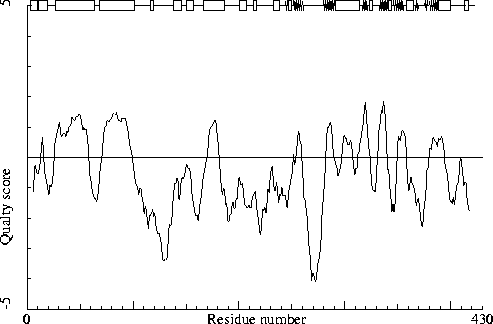
Chain without chain identifier
Warning: Low packing Z-score for some residues
The residues listed in the table below have an unusual packing
environment according to the 2nd generation quality check. The score
listed in the table is a packing normality Z-score: positive means
better than average, negative means worse than average. Only residues
scoring less than -2.50 are listed here. These are the "unusual"
residues in the structure, so it will be interesting to take a
special look at them.
276 ILE ( 282 ) -2.68 188 HIS ( 188 ) -2.65 194 TYR ( 194 ) -2.61
All contacts : Average = -0.038 Z-score = -0.10
BB-BB contacts : Average = 0.250 Z-score = 1.80
BB-SC contacts : Average = -0.343 Z-score = -1.79
SC-BB contacts : Average = 0.146 Z-score = 1.06
SC-SC contacts : Average = -0.277 Z-score = -1.21
Note: Second generation quality Z-score plot
The second generation quality Z-score smoothed over a 10 residue window
is plotted as function of the residue number. Low areas in the plot (below
-1.3) indicate "unusual" packing.
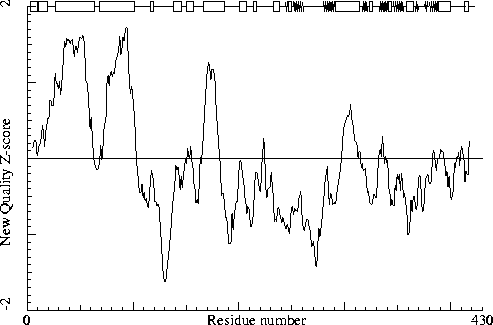
Chain without chain identifier
Warning: Backbone oxygen evaluation
The residues listed in the table below have an unusual backbone
oxygen position.
For each of the residues in the structure, a search was performed to find 5-residue stretches in the WHAT IF database with superposable C-alpha coordinates, and some constraints on the neighboring backbone oxygens.
In the following table the RMS distance between the backbone oxygen positions of these matching structures in the database and the position of the backbone oxygen atom in the current residue is given. If this number is larger than 1.5 a significant number of structures in the database show an alternative position for the backbone oxygen. If the number is larger than 2.0 most matching backbone fragments in the database have the peptide plane flipped. A manual check needs to be performed to assess whether the experimental data can support that alternative as well. The number in the last column is the number of database hits (maximum 80) used in the calculation. It is "normal" that some glycine residues show up in this list, but they are still worth checking!
131 GLY ( 131 ) 1.92 37
It is not necessarily an error if a few residues have rotamer values below 0.3, but careful inspection of all residues with these low values could be worth it.
383 ASN ( 389 ) 0.38 97 SER ( 97 ) 0.39 283 LYS ( 289 ) 0.40
For this check, backbone conformations are compared with database structures using C-alpha superpositions with some restraints on the backbone oxygen positions.
A residue mentioned in the table can be part of a strange loop, or there might be something wrong with it or its directly surrounding residues. There are a few of these in every protein, but in any case it is worth looking at!
158 SER ( 158 ) 0 210 LEU ( 210 ) 0 250 LEU ( 256 ) 0 270 LYS ( 276 ) 0 371 PRO ( 377 ) 0 387 LEU ( 393 ) 0 356 CYS ( 362 ) 1 357 GLU ( 363 ) 1 161 ARG ( 161 ) 2 223 ASP ( 229 ) 2
Backbone conformation Z-score : 0.260
B-factor analysis
Note: Average B-factor OK
The average B-factor of buried atoms is within expected values for
a room-temperature X-ray study.
Average B-factor for buried atoms : 23.826
Note: Number of buried atoms with low B-factor is OK
For protein structures determined at room temperature, no more than
about 1 percent of the B factors of buried atoms is below 5.0.
Percentage of buried atoms with B less than 5 : 0.13
Error: The B-factors of bonded atoms show signs of over-refinement
For each of the bond types in a protein a distribution was derived
for the difference between the square roots of the B-factors of the
two atoms. All bonds in the current protein were scored against
these distributions. The number given below is the RMS Z-score over
the structure. For a structure with completely restrained B-factors
within residues, this value will be around 0.35, for extremely high
resolution structures refined with free isotropic B-factors this
number is expected to be near 1.0. Any value over 1.5 is sign of
severe over-refinement of B-factors.
RMS Z-score : 1.919 over 2917 bonds
Average difference in B over a bond : 2.40
RMS difference in B over a bond : 5.83
Note: B-factor plot
The average atomic B-factor per residue is plotted as function of
the residue number.
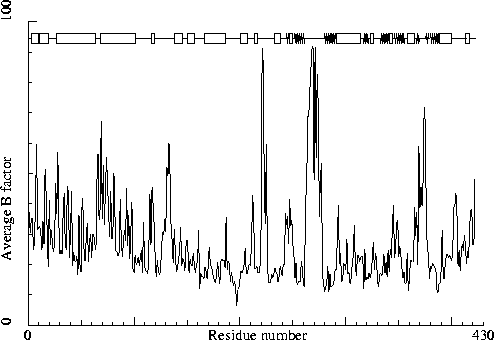
Chain without chain identifier
Hydrogen bond related checks
Error: HIS, ASN, GLN side chain flips
Listed here are Histidine, Asparagine or Glutamine residues for
which the orientation determined from hydrogen bonding analysis are
different from the assignment given in the input. Either they could
form energetically more favorable hydrogen bonds if the terminal
group was rotated by 180 degrees, or there is no assignment in the
input file (atom type 'A') but an assignment could be made. If a
residue is marked ``flexible'' the flipped conformation is only
slightly better than the non-flipped conformation.
41 GLN ( 41 ) 125 GLN ( 125 ) 188 HIS ( 188 ) 355 ASN ( 361 )
In the table below all normal histidine residues are listed. The assignment based on the geometry of the residue is listed first, together with the RMS Z-score for the fit to the Engh and Huber parameters. For all residues where the H-bond assignment is different, the assignment is listed in the last columns, together with its RMS Z-score to the Engh and Huber parameters.
As always, the RMS Z-scores should be close to 1.0 if the residues were restrained to the Engh and Huber parameters during refinement.
Please note that because the differences between the geometries of the different types are small it is possible that the geometric assignment given here does not correspond to the type used in refinement. This is especially true if the RMS Z-scores are much higher than 1.0.
If the two assignments differ, or the ``geometry'' RMS Z-score is high, it is advisable to verify the hydrogen bond assignment, check the HIS type used during the refinement and possibly adjust it.
13 HIS ( 13 ) HIS-D 0.77 108 HIS ( 108 ) HIS-E 0.85 139 HIS ( 139 ) HIS-E 0.72 HIS-D 0.88 173 HIS ( 173 ) HIS-D 0.72 HIS-E 0.88 184 HIS ( 184 ) HIS-D 0.78 HIS-E 0.91 188 HIS ( 188 ) HIS-D 0.76 200 HIS ( 200 ) HIS-D 0.77 HIS-E 0.85 279 HIS ( 285 ) HIS-D 0.77 380 HIS ( 386 ) HIS-E 0.70 406 HIS ( 412 ) HIS-D 0.78 HIS-E 0.85
Hydrogen bond donors that are buried inside the protein normally use all of their hydrogens to form hydrogen bonds within the protein. If there are any non hydrogen bonded buried hydrogen bond donors in the structure they will be listed here. In very good structures the number of listed atoms will tend to zero.
1 MET ( 1 ) N 25 MET ( 25 ) N 37 ARG ( 37 ) NE 70 LEU ( 70 ) N 71 LEU ( 71 ) N 118 ASN ( 118 ) N 120 ASN ( 120 ) N 140 THR ( 140 ) N 162 PHE ( 162 ) N 212 LYS ( 212 ) N 217 GLN ( 217 ) NE2 218 PHE ( 218 ) N 224 ARG ( 230 ) N 226 PHE ( 232 ) N 231 THR ( 237 ) N 273 ARG ( 279 ) NH2 274 GLY ( 280 ) N 275 MET ( 281 ) N 280 GLN ( 286 ) N 282 GLN ( 288 ) N 297 GLN ( 303 ) N 318 ARG ( 324 ) NE 346 LYS ( 352 ) N 358 ASP ( 364 ) N 360 GLN ( 366 ) N 361 ALA ( 367 ) N 363 ARG ( 369 ) NE 363 ARG ( 369 ) NH2 391 ARG ( 397 ) NE
Side-chain hydrogen bond acceptors that are buried inside the protein normally form hydrogen bonds within the protein. If there are any not hydrogen bonded in the optimized hydrogen bond network they will be listed here.
85 GLU ( 85 ) OE1 217 GLN ( 217 ) OE1 278 GLN ( 284 ) OE1 285 GLU ( 291 ) OE1 399 ASN ( 405 ) OD1
The second part of the table mostly gives an impression of how well the model conforms to common refinement constraint values. The first part of the table shows a number of constraint-independent quality indicators.
Structure Z-scores, positive is better than average:
1st generation packing quality : -0.291 2nd generation packing quality : -0.099 Ramachandran plot appearance : -1.741 chi-1/chi-2 rotamer normality : -1.476 Backbone conformation : 0.260
Bond lengths : 0.789 Bond angles : 0.898 Omega angle restraints : 0.639 (tight) Side chain planarity : 0.061 (tight) Improper dihedral distribution : 0.584 B-factor distribution : 1.919 (loose) Inside/Outside distribution : 1.025